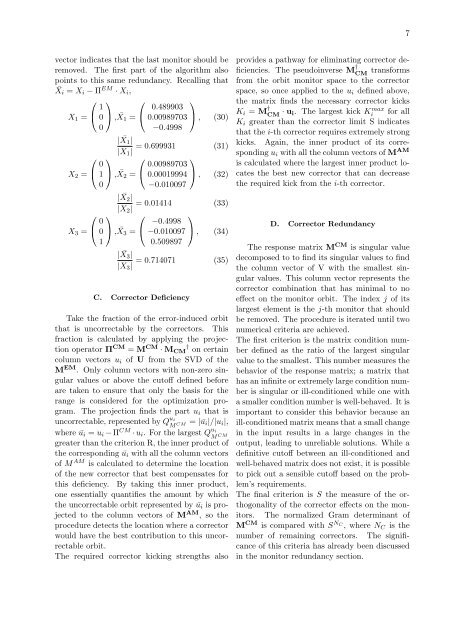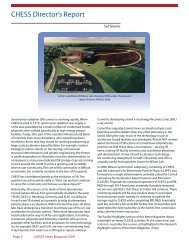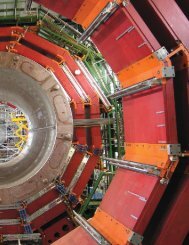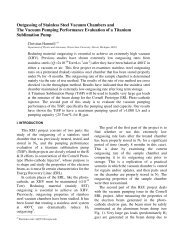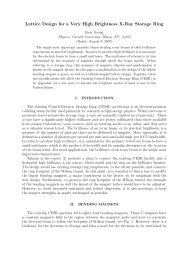Analysis and Optimization of Singular Value Decomposition Orbit ...
Analysis and Optimization of Singular Value Decomposition Orbit ...
Analysis and Optimization of Singular Value Decomposition Orbit ...
Create successful ePaper yourself
Turn your PDF publications into a flip-book with our unique Google optimized e-Paper software.
7<br />
vector indicates that the last monitor should be<br />
removed. The first part <strong>of</strong> the algorithm also<br />
points to this same redundancy. Recalling that<br />
¯X i = X i − Π EM · X i ,<br />
⎛<br />
X 1 = ⎝<br />
⎛<br />
X 2 = ⎝<br />
⎛<br />
X 3 = ⎝<br />
⎞ ⎛<br />
1<br />
0 ⎠ , ¯X 1 = ⎝<br />
0<br />
⎞<br />
0.489903<br />
0.00989703 ⎠ , (30)<br />
−0.4998<br />
| ¯X 1 |<br />
= 0.699931 (31)<br />
|X 1 |<br />
⎛<br />
⎞<br />
0<br />
1 ⎠ , ¯X 2 =<br />
0<br />
⎝<br />
⎞<br />
0.00989703<br />
0.00019994 ⎠ , (32)<br />
−0.010097<br />
| ¯X 2 |<br />
= 0.01414 (33)<br />
|X 2 |<br />
⎛<br />
⎞<br />
0<br />
0 ⎠ , ¯X 3 =<br />
1<br />
⎝<br />
⎞<br />
−0.4998<br />
−0.010097 ⎠ , (34)<br />
0.509897<br />
| ¯X 3 |<br />
= 0.714071 (35)<br />
|X 3 |<br />
C. Corrector Deficiency<br />
Take the fraction <strong>of</strong> the error-induced orbit<br />
that is uncorrectable by the correctors. This<br />
fraction is calculated by applying the projection<br />
operator Π CM = M CM · M † CM on certain<br />
column vectors u i <strong>of</strong> U from the SVD <strong>of</strong> the<br />
M EM . Only column vectors with non-zero singular<br />
values or above the cut<strong>of</strong>f defined before<br />
are taken to ensure that only the basis for the<br />
range is considered for the optimization program.<br />
The projection finds the part u i that is<br />
uncorrectable, represented by Q u i<br />
M CM = |ū i |/|u i |,<br />
where ū i = u i − Π CM · u i . For the largest Q u i<br />
M CM<br />
greater than the criterion R, the inner product <strong>of</strong><br />
the corresponding ū i with all the column vectors<br />
<strong>of</strong> M AM is calculated to determine the location<br />
<strong>of</strong> the new corrector that best compensates for<br />
this deficiency. By taking this inner product,<br />
one essentially quantifies the amount by which<br />
the uncorrectable orbit represented by ū i is projected<br />
to the column vectors <strong>of</strong> M AM , so the<br />
procedure detects the location where a corrector<br />
would have the best contribution to this uncorrectable<br />
orbit.<br />
The required corrector kicking strengths also<br />
provides a pathway for eliminating corrector deficiencies.<br />
The pseudoinverse M † CM transforms<br />
from the orbit monitor space to the corrector<br />
space, so once applied to the u i defined above,<br />
the matrix finds the necessary corrector kicks<br />
K i = M † CM · u i. The largest kick Ki<br />
max for all<br />
K i greater than the corrector limit S indicates<br />
that the i-th corrector requires extremely strong<br />
kicks. Again, the inner product <strong>of</strong> its corresponding<br />
u i with all the column vectors <strong>of</strong> M AM<br />
is calculated where the largest inner product locates<br />
the best new corrector that can decrease<br />
the required kick from the i-th corrector.<br />
D. Corrector Redundancy<br />
The response matrix M CM is singular value<br />
decomposed to to find its singular values to find<br />
the column vector <strong>of</strong> V with the smallest singular<br />
values. This column vector represents the<br />
corrector combination that has minimal to no<br />
effect on the monitor orbit. The index j <strong>of</strong> its<br />
largest element is the j-th monitor that should<br />
be removed. The procedure is iterated until two<br />
numerical criteria are achieved.<br />
The first criterion is the matrix condition number<br />
defined as the ratio <strong>of</strong> the largest singular<br />
value to the smallest. This number measures the<br />
behavior <strong>of</strong> the response matrix; a matrix that<br />
has an infinite or extremely large condition number<br />
is singular or ill-conditioned while one with<br />
a smaller condition number is well-behaved. It is<br />
important to consider this behavior because an<br />
ill-conditioned matrix means that a small change<br />
in the input results in a large changes in the<br />
output, leading to unreliable solutions. While a<br />
definitive cut<strong>of</strong>f between an ill-conditioned <strong>and</strong><br />
well-behaved matrix does not exist, it is possible<br />
to pick out a sensible cut<strong>of</strong>f based on the problem’s<br />
requirements.<br />
The final criterion is S the measure <strong>of</strong> the orthogonality<br />
<strong>of</strong> the corrector effects on the monitors.<br />
The normalized Gram determinant <strong>of</strong><br />
M CM is compared with S N C<br />
, where N C is the<br />
number <strong>of</strong> remaining correctors. The significance<br />
<strong>of</strong> this criteria has already been discussed<br />
in the monitor redundancy section.


